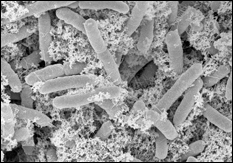
|
 |
Scanning electron microscope image of the magnetic nanofactories attached to targeted E. coli cells.
|
|
The list of side effects on your prescription bottle may one day be a lot shorter, according to researchers at the University of Maryland's A. James Clark School of Engineering.
That's because instead of taking a conventional medication, you may swallow tiny "nanofactories," biochemical machines that act like cells, first conceived of at the Clark School.
For example, these ingested nanofactories, using magnetism, could detect a bacterial infection, produce a medication using the body's own materials, and deliver a dose directly to the bacteria. The drug would do its work only at the infection site, and thus not cause the side effects that may arise when an antibiotic travels throughout the body in search of infections.
William Bentley, professor and chair of the Fischell Department of Bioengineering at the Clark School, and several graduate students including Rohan Fernandes, have developed this "magnetic nanofactory" concept and published their research in Metabolic Engineering in December of last year. Colleagues around the country voiced their support for the technology in Nature Nanotechnology last month.
"In the lab," Bentley says, "our group showed we can produce a tiny nanofactory and attach it to a target cell magnetically. The nanofactory then makes small molecules from surrounding materials and delivers the molecules?potentially drug molecules?to the targeted cell."
Besides drug molecules, the researchers showed that the nanofactory could produce signaling molecules that communicate with the target cell or block the target cell from communicating with other, similar cells (a process called "quorum sensing") and thus prevent infection. The researchers attached the nanofactories to E. coli cells, targeting them with the help of a mixture of iron particles and chitosan, a substance derived from the shells of crustaceans like crabs and shrimp. The nanofactories then produced a signaling molecule that could render the E. coli harmless. Nanofactories could be designed to produce the needed drug molecules over an extended period of time.
Now that the viability of nanofactories has been shown, researchers must overcome a few challenges before they can be used in humans. First, nanofactories must be cloaked so that the body does not react to them as a foreign substance and try to attack them. Another goal is to find a method to shut down the nanofactory once it has produced the needed substance?a type of off-switch that could be activated from outside the body. These and other topics are being investigated in the Fischell Department of Bioengineering.
View the related press release.
View local TV news coverage (WMV) (MOV) of this story (footage courtesy of CTV76).
Related Articles:
Fight Bacteria With Bacteria
"Bacterial Dirigibles" Emerge as Next-Generation Disease Fighters
Bentley Group Research Selected for Highlights in Chemical Technology
Bentley Group Research Featured in Nature Nanotechnology
Roy Wins Zain Award
Fernandes Wins ACS's Peterson Award
Quorum Sensing Research Wins $2.5M DoD Contract
Advance in Creating in Vitro Programmable Biological Microfactories
$2M NSF Grant for "Bacterial Communication"
$1 Million For Nano-Bio Initiative
February 27, 2007
|